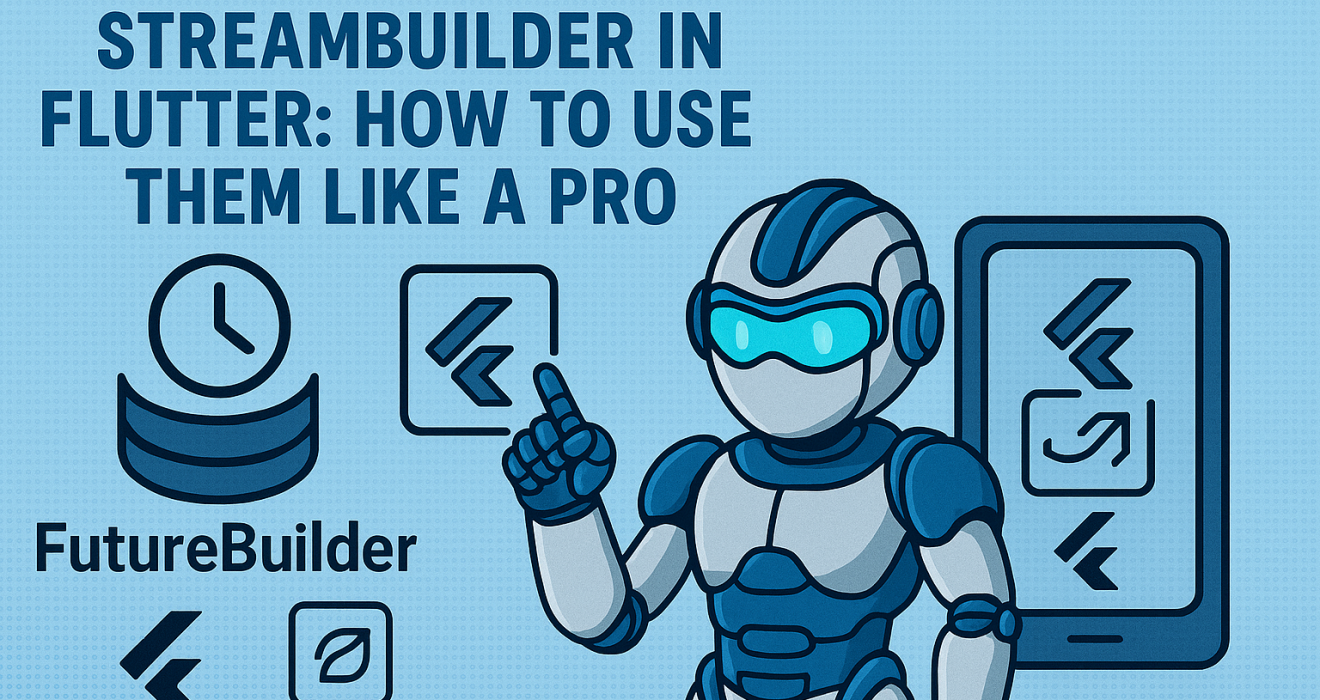FutureBuilder and StreamBuilder in Flutter: How to Use Them Like a Pro
Introduction
Handling asynchronous data effectively is essential in Flutter, and mastering FutureBuilder and StreamBuilder in Flutter is key to building dynamic, reactive UIs. These two widgets are powerful tools that allow Flutter developers to manage futures and streams efficiently, enabling seamless updates to the user interface as data changes.
When dealing with asynchronous operations such as fetching API results or listening to real-time database updates, FutureBuilder and StreamBuilder in Flutter provide elegant solutions to keep your app responsive and maintainable.
Best Practices for FutureBuilder and StreamBuilder in Flutter
When choosing between FutureBuilder and StreamBuilder in Flutter, consider the nature of your data. Use FutureBuilder for one-time data loading and StreamBuilder for continuous updates.
What is FutureBuilder?
A widget that builds itself based on the latest snapshot of a
Future.Used for one-time async operations like API calls, reading local files, DB queries, etc.
FutureBuilder<T>(
future: someFuture,
builder: (context, snapshot) {
if (snapshot.connectionState == ConnectionState.waiting) {
return CircularProgressIndicator();
} else if (snapshot.hasError) {
return Text('Error: ${snapshot.error}');
} else if (snapshot.hasData) {
return Text('Data: ${snapshot.data}');
}
return SizedBox();
},
)
What is StreamBuilder?
- A widget that builds itself based on the latest snapshot of interaction with a
Stream. - Ideal for real-time data like chat messages, location updates, or Firebase Firestore data.
StreamBuilder<T>(
stream: someStream,
builder: (context, snapshot) {
if (snapshot.connectionState == ConnectionState.waiting) {
return CircularProgressIndicator();
} else if (snapshot.hasError) {
return Text('Error: ${snapshot.error}');
} else if (snapshot.hasData) {
return Text('Data: ${snapshot.data}');
}
return SizedBox();
},
)FutureBuilder – Use Cases, Syntax & Best Practices
Use Cases:
Fetching user profile on app start
API call to load product list
Read a file from device
Best Practices:
Avoid calling
Futureinside thebuild()methodUse a
late Future<T>orinitStateto initialize the FutureShow proper loading and error handling UI
late Future<User> userFuture;
@override
void initState() {
super.initState();
userFuture = fetchUser();
}StreamBuilder – Use Cases, Syntax & Best Practices
Use Cases:
Firebase Firestore or Realtime DB live data
Bluetooth data stream
Socket connections
Best Practices:
Handle
ConnectionState.waitingfor loading statesDon’t forget to dispose the stream when using manual subscriptions
Stream<int> timerStream = Stream.periodic(Duration(seconds: 1), (i) => i);
StreamBuilder<int>(
stream: timerStream,
builder: (context, snapshot) {
if (snapshot.hasData) {
return Text("Timer: ${snapshot.data}");
}
return CircularProgressIndicator();
},
)Common Mistakes and How to Avoid Them
| Mistake | Solution |
|---|---|
Creating the Future inside build() | Move it to initState() or use a state variable |
| Not handling errors | Always check snapshot.hasError |
Ignoring connectionState | Use it to show loading indicators |
| Subscribing to unnecessary streams | Use stream only when needed, and close subscriptions if using StreamSubscription manually |
When to Use Which: FutureBuilder vs StreamBuilder
| Use Case | Widget |
|---|---|
| One-time data fetch | FutureBuilder |
| Continuous data updates | StreamBuilder |
| Firebase Firestore | StreamBuilder |
| HTTP request | FutureBuilder |
| Timer/clock | StreamBuilder |
Real-World Examples
FutureBuilder – Fetch Weather
FutureBuilder<Weather>(
future: weatherService.getWeather(),
builder: (context, snapshot) {
if (snapshot.hasData) {
return WeatherWidget(data: snapshot.data!);
}
return CircularProgressIndicator();
},
)StreamBuilder – Firebase Firestore Chat
StreamBuilder<QuerySnapshot>(
stream: FirebaseFirestore.instance.collection('messages').snapshots(),
builder: (context, snapshot) {
if (snapshot.hasData) {
return ListView(
children: snapshot.data!.docs.map((doc) => Text(doc['text'])).toList(),
);
}
return CircularProgressIndicator();
},
)Conclusion
By mastering FutureBuilder and StreamBuilder in Flutter, developers can manage asynchronous data flows efficiently and build fast, responsive, and production-ready apps.
Mastering FutureBuilder and StreamBuilder in Flutter is key to building efficient and responsive apps.

